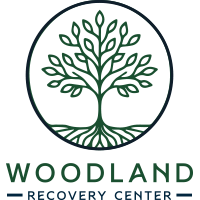Alcoholics Anonymous (AA) is probably the most widely known 12-step recovery program. However, it’s not the only one that exists. Many other programs have adopted the 12-step model due to its effectiveness in helping individuals overcome addiction. What are the 12 steps of AA? Understanding these steps can provide insight into how they guide people through recovery. If you’d like to learn more about the 12-step program at Woodland Recovery Center, call us today, and we’d be happy to talk with you.
The Purpose of the AA 12 Steps
The spiritual principles of the 12 steps serve as a framework for people to recover from alcohol addiction by fostering personal growth, accountability, and healing. Each step builds upon the previous one, with goals that include:
- Learning from others in recovery
- Recognizing and accepting addiction
- Developing hope and faith in the recovery process
- Repairing broken relationships
- Establishing a sober support network
- Identifying and addressing the root causes of addiction
- Cultivating self-awareness and self-improvement
- Helping others in their recovery journey
Though rooted initially in Christian beliefs, AA has since evolved to include all spiritual or secular perspectives. No religious belief or affiliation is necessary to join AA or benefit from the program.
What Are the 12 Steps of Alcoholics Anonymous?
What are the 12 steps of AA? The Alcoholics Anonymous website presents the original 12 Steps, which include the following:
- Admitting powerlessness
- Believing in a Higher Power
- Surrendering to a Higher Power
- Conducting a moral inventory
- Confessing wrongdoings
- Becoming ready for change
- Seeking humility
- Making amends list
- Making direct amends
- Continuing self-reflection
- Seeking spiritual growth
- Carrying the message
Each of these steps guides individuals toward a healthier, alcohol-free life by fostering personal accountability, emotional healing, and a commitment to sobriety.
How to Work the 12 Steps of AA
Step 1: Acknowledge Powerlessness and Accept the Need for Change
The first step is admitting how alcohol has impacted your life and recognizing you’re powerless over it. This means acknowledging issues like strained relationships, financial struggles, or health problems caused by drinking. Accepting the need for change is the foundation of recovery and seeking help.
Step 2: Develop an Open Mind Toward Outside Help
Step 2 encourages accepting support, whether through spiritual guidance, a higher power, or a supportive community. It reminds you that hope exists beyond your struggles and that outside help can provide the strength to overcome alcohol dependency.
Step 3: Make a Conscious Decision to Embrace Recovery
In Step 3, you commit to recovery by making a deliberate decision to let go of control and trust in a higher power or guiding force. This step is about surrendering the need to do it all on your own and embracing the process of seeking guidance and support, whether through a spiritual belief system or the AA community.
Step 4: Conduct an Honest and Fearless Self-Inventory
This step calls for deep introspection. Writing a personal inventory involves identifying past behaviors, fears, resentments, and patterns of thinking that contributed to your struggles with alcohol. It’s a comprehensive look inward to understand yourself better and take accountability for your actions.
Step 5: Share Your Inventory with a Trusted Individual and Higher Power
Once your self-inventory is complete, Step 5 is about sharing it. Confiding in a trusted person, whether that’s a mentor, sponsor, or spiritual advisor, helps bring your struggles into the open. It’s also an opportunity to release the burden of secrecy and shame while fostering honesty and accountability.
Step 6: Reflect on Personal Defects and Become Willing to Change
In Step 6, you identify personal flaws or character defects that have held you back. This step is about self-awareness and willingness—acknowledging the areas in your life that need improvement and becoming open to addressing them. It’s a moment to prepare yourself mentally and emotionally for real change.
Step 7: Seek Humility and Act on Improving Shortcomings
Step 7 is about seeking humility and asking for help to improve your shortcomings. Whether through prayer, meditation, or personal reflection, this step involves letting go of pride and accepting that personal growth requires effort and support. It’s a step toward becoming the best version of yourself.
Step 8: List Those You Have Harmed and Prepare to Make Amends
Recovery is not just about self-improvement—it also involves repairing relationships. Step 8 requires creating a list of people you’ve harmed due to your alcohol dependency. This step isn’t about immediate action but about preparing to make amends and taking responsibility for the impact your actions have had on others.
Step 9: Make Amends Where Possible Without Causing Harm
Step 9 is the act of making amends. This could involve apologizing directly, repaying debts, or making other reparations. However, careful consideration is required to avoid causing further harm to the individuals involved. It’s a step of healing and reconciliation.
Step 10: Continue Self-Evaluation and Admit Faults
Recovery is an ongoing process, and Step 10 emphasizes the importance of regular self-reflection. By continuing to evaluate your actions and promptly admitting when you’re wrong, you can maintain a level of honesty and accountability that supports long-term sobriety.
Step 11: Cultivate Inner Peace Through Prayer or Meditation
Step 11 encourages the practice of mindfulness and spiritual connection through prayer or meditation. This step is about seeking guidance, finding inner peace, and strengthening your resolve to stay on the path of recovery. It’s a practice that fosters clarity and emotional balance.
Step 12: Support Others and Share Your Recovery Journey
The final step is about giving back. By sharing your experiences and supporting others in their recovery journeys, you reinforce your own commitment to sobriety. Helping others provides a sense of purpose and fulfillment, making recovery a collective effort rather than a personal struggle.
The Role of Al-Anon’s 12 Steps in Family Support
For those with a loved one struggling with alcohol addiction, Al-Anon’s 12 steps offer a parallel recovery process. Al-Anon provides support to family members and friends affected by another person’s drinking, helping them develop coping strategies, emotional resilience, and self-care practices.
The Al-Anon 12 steps follow a similar structure to AA, emphasizing acceptance, personal reflection, and spiritual growth. However, instead of focusing on controlling a loved one’s drinking, the steps encourage family members to prioritize their well-being and develop healthier responses to challenging situations.
Call Woodland Recovery Center and Join a 12-Step Program at Our Center
We recognize that participation in a 12-step program is a valuable tool in alcohol recovery. Our comprehensive treatment approach incorporates multiple recovery strategies, including spiritual principles of the 12 steps and individualized therapy. If you’re ready to begin your recovery journey, call Woodland Recovery Center today at 662.222.2989 or contact us online.



